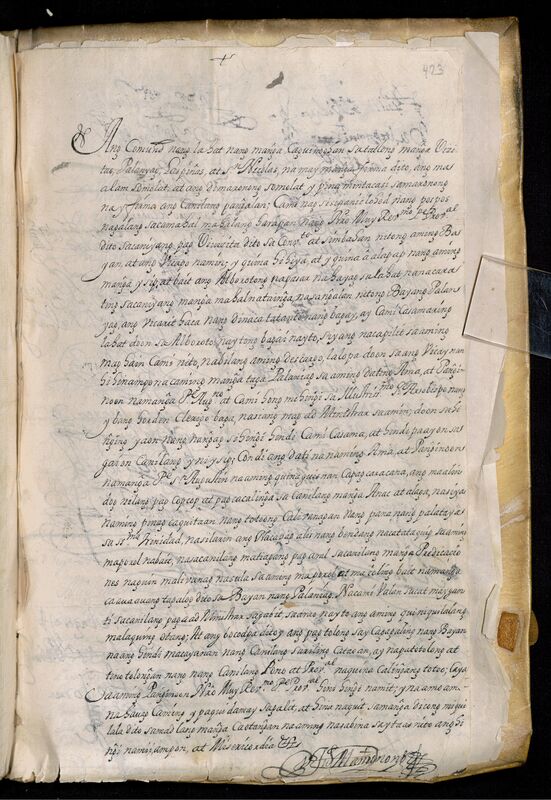Palanyag
- Title
- Palanyag
- category
- Philippines -- Places -- Luzon
- isBasedOnUrl
- https://fromthepage.com/1762archive/a-digital-repatriation-of-a-lost-archive-of-the-spanish-pacific-the-library-of-the-convent-of-san-pablo-manila-1762/article/32076749
- targetUrl
- https://www.google.com/maps/place/Para%C3%B1aque,+Metro+Manila/@14.479591087900546, 121.0091894186102,13z/
- name
- Palanyag
- contentUrl
- 32076749
- location
- 14.479591087900546, 121.0091894186102
- valueMinLength
- 285
- valueMaxLength
- 1719
- description
- District in Manila, the old name of Parañaque. Several myths exist as to how Parañaque got its name. One story holds that long ago, a balete (banyan) tree that looked like a majestic ship stood at the mouth of what is now called the Parañaque River. It earned the name Palanyag, taken from the term "palayag", which means “point of navigation”.[6] Another folktale says that before the Spaniards arrived, there were natives who lived close to Manila Bay, and their occupation was fishing (pangingisdâ). Their neighbours to the east in modern Muntinlupa were farmers and called "tagá-palayán" ("of the rice paddies"). One day, the fishermen and rice farmers held a feast, and were drunk from tubâ (coconut toddy). One farmer suggested they name the whole place "Palayán" as a sign of cooperation and goodwill between them. A fisherman protested, saying they should name it "Palalayag" instead. As a compromise, they agreed to merge the two words and came up with "Palalanyag". Another drunken guest shouted, “Mabuhay ang Palanyag at ang mga tagá-Palanyag!” ("Long live Palanyag and those of Palanyag!") The rest liked this word better, and the place was called "Palanyag".[6] A third myth tells that Spanish soldiers in a horse-drawn carriage asked to be taken to a certain place. When they arrived, one of the soldiers ordered, "¡Para aquí! ¡Para aquí!" (“Stop here! Stop here!”), which the coachman did not understand. The soldier repeated it and later, the coachman left the carriage and told others “These Spaniards are repeatedly saying "para aniya ake...para aniya ake” to the laughter of the crowd. The story spread, and the term "Para Aniya Ake" stuck.[6] https://en.wikipedia.org/wiki/Para%C3%B1aque
- numberOfItems
- 5
Location of Palanyag
Found 14 Instances of "Palanyag" on 1 Pages
Relación y otros instrumentos sobre el desacato de los Naturales de Dongalo. 1717.

Ang comunidad nang lahat nang mañga caguinoohan sa tatlong manga visitas,
Palanyag, Las Piñas, at San Nicolas, na may mañga firma dito, ang maalam
somolat at ang di maronong somolat ypinamintacasi sa maronong
na yfirma ang canilang panĝalan; Cami nagsisipaniclohod nang pospos
na galang sa camahal-mahalang harapan nang nuestro muy reverendísimo padre provincial
dito sa caniyang pagvivizita dito sa convento at simbahan nitong aming bayan
at ang uica po namin; yquinahihiya, at yquinaâalapap nang aming
manĝa ysip, at bait ang alborotong napasar nahayag sa lahat, na nacarating
sa caniyang mañga mahal na tainĝa, na sa ngalan nitong bayang Palanyag,
ang [uicari't haca] nang di nacatatanto nang bagay, ay cami casama ring
lahat doon sa alboroto, na ytong bagai na yto, siyang nacapilit sa aming
maghain cami nito, na bilang aming descargo, lalo pa doon sa ang uica'y nanhihinampo
na caming manĝa taga-Palaniag sa aming dating Ama, at Pañginoon
na manĝa padre augustino at cami hongmihingi sa ilustrísimo señor arsobispo nang
ybang horden clerigo baga, na siang mag-administrar sa amin; doon sa hiñging
yaon nang nanĝagsihinĝi hindi cami casama, at hindi pa ayon sa
gaion canilang yniysip; condi ang dati na naming Ama at Panĝinoon
na manĝa padre San Agustin na aming quinaguisnan capag [caracana] ang maalindog
nilang pagcopcop at pagcacalinĝa sa canilang manĝa anac at alaga, na siya
naming pinagcaquitaan nang totoong caliuanagan nang pananangpalataya
sa Santísima Trinidad, na sila rin ang nacapag-alis nang bendang nacatataquip sa aming
maporol na bait, na sa canilang matiagang pag-aral sa canilang manĝa predicaciones
naguin maliuanag [nasula] sa aming maporol at maicling bait na manĝa
caaua-auang tagalog dito sa bayan nang Palaniag. Na cami ualan sucat may ganti
sa canilang pagaadministar sa gabi't, sa arao, na yto ang aming quiniquilalang
malaquing otang; At ang bocod pa dito 'y ang pagtolong sa ycagagaling nang bayan
na ang hindi macayanan nang canilang sariling cataoan, ay napatotolong at
tinotolonĝan nang nang canilang pono at provincial na quinacalinĝang totoo; caya
sa aming pañginoon nuestro muy reverendísimo padre provincial hinihinĝi nami't; ynaamo [am]
na huag caming ypaquidamay sa galit, at hinanaquit sa manĝa di congmiquilala
dito sa madlang mañga caotanĝan na aming nasabi na sa ytaas nito ang hinĝi
[nami' i] ampon, at misericordia etc
Don Juan Mamonong






 Full Width
Full Width 